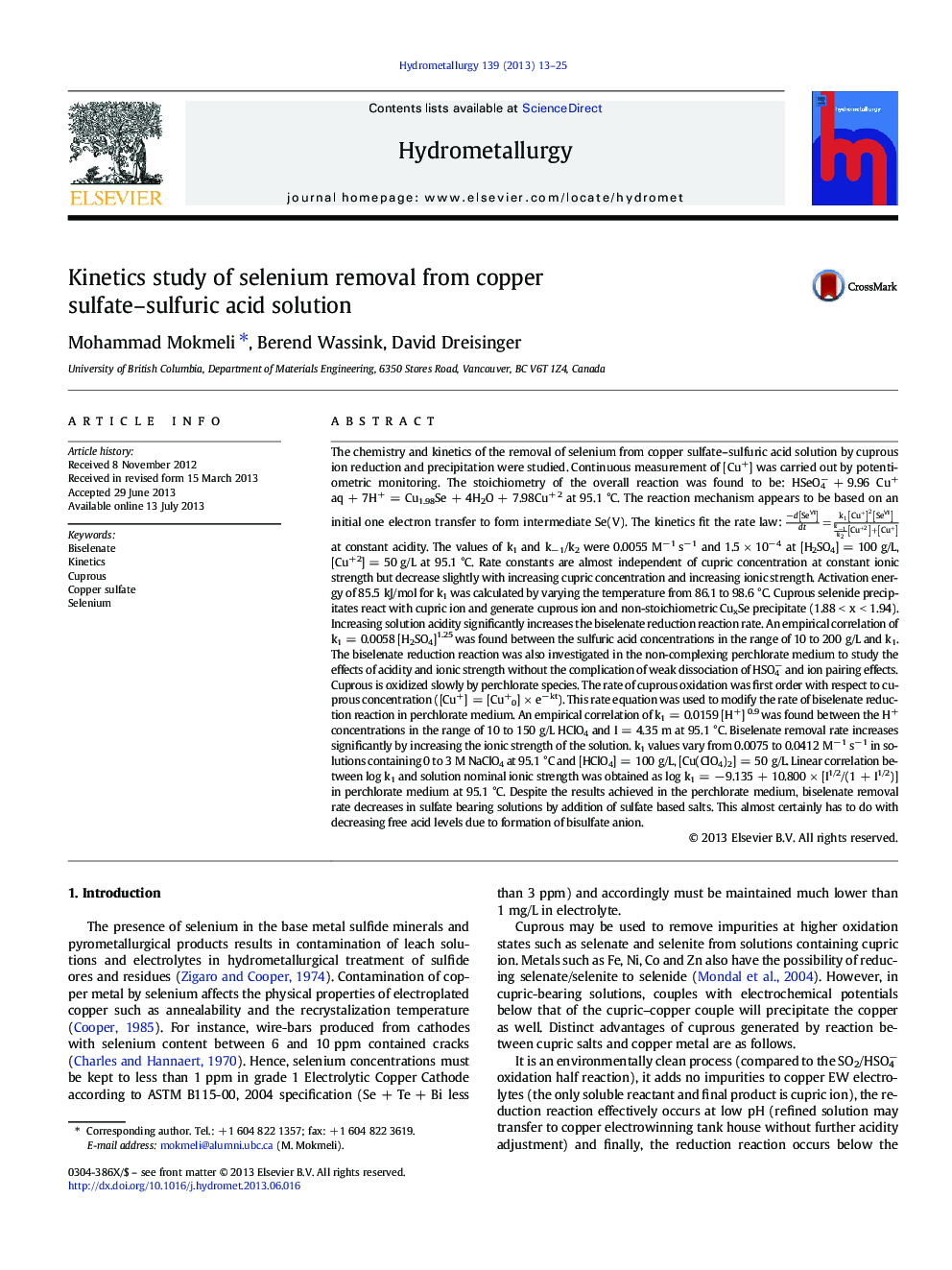| کد مقاله | کد نشریه | سال انتشار | مقاله انگلیسی | نسخه تمام متن |
|---|---|---|---|---|
| 212334 | 462044 | 2013 | 13 صفحه PDF | دانلود رایگان |

• The kinetics of the biselenate removal by cuprous ion reduction was investigated.
• The mechanism of biselenate reduction and its corresponding rate law was suggested.
• Effects of temperature, acidity, activity and cupric concentration were studied.
The chemistry and kinetics of the removal of selenium from copper sulfate–sulfuric acid solution by cuprous ion reduction and precipitation were studied. Continuous measurement of [Cu+] was carried out by potentiometric monitoring. The stoichiometry of the overall reaction was found to be: HSeO4− + 9.96 Cu+ aq + 7H+ = Cu1.98Se + 4H2O + 7.98Cu+ 2 at 95.1 °C. The reaction mechanism appears to be based on an initial one electron transfer to form intermediate Se(V). The kinetics fit the rate law: −dSeVIdt=k1Cu+2SeVIk−1k2Cu+2+Cu+ at constant acidity. The values of k1 and k− 1/k2 were 0.0055 M− 1 s− 1 and 1.5 × 10− 4 at [H2SO4] = 100 g/L, [Cu+ 2] = 50 g/L at 95.1 °C. Rate constants are almost independent of cupric concentration at constant ionic strength but decrease slightly with increasing cupric concentration and increasing ionic strength. Activation energy of 85.5 kJ/mol for k1 was calculated by varying the temperature from 86.1 to 98.6 °C. Cuprous selenide precipitates react with cupric ion and generate cuprous ion and non-stoichiometric CuxSe precipitate (1.88 < x < 1.94). Increasing solution acidity significantly increases the biselenate reduction reaction rate. An empirical correlation of k1 = 0.0058 [H2SO4]1.25 was found between the sulfuric acid concentrations in the range of 10 to 200 g/L and k1. The biselenate reduction reaction was also investigated in the non-complexing perchlorate medium to study the effects of acidity and ionic strength without the complication of weak dissociation of HSO4− and ion pairing effects. Cuprous is oxidized slowly by perchlorate species. The rate of cuprous oxidation was first order with respect to cuprous concentration ([Cu+] = [Cu+0] × e− kt). This rate equation was used to modify the rate of biselenate reduction reaction in perchlorate medium. An empirical correlation of k1 = 0.0159 [H+] 0.9 was found between the H+ concentrations in the range of 10 to 150 g/L HClO4 and I = 4.35 m at 95.1 °C. Biselenate removal rate increases significantly by increasing the ionic strength of the solution. k1 values vary from 0.0075 to 0.0412 M− 1 s− 1 in solutions containing 0 to 3 M NaClO4 at 95.1 °C and [HClO4] = 100 g/L, [Cu(ClO4)2] = 50 g/L. Linear correlation between log k1 and solution nominal ionic strength was obtained as log k1 = − 9.135 + 10.800 × [I1/2/(1 + I1/2)] in perchlorate medium at 95.1 °C. Despite the results achieved in the perchlorate medium, biselenate removal rate decreases in sulfate bearing solutions by addition of sulfate based salts. This almost certainly has to do with decreasing free acid levels due to formation of bisulfate anion.
Journal: Hydrometallurgy - Volume 139, July 2013, Pages 13–25